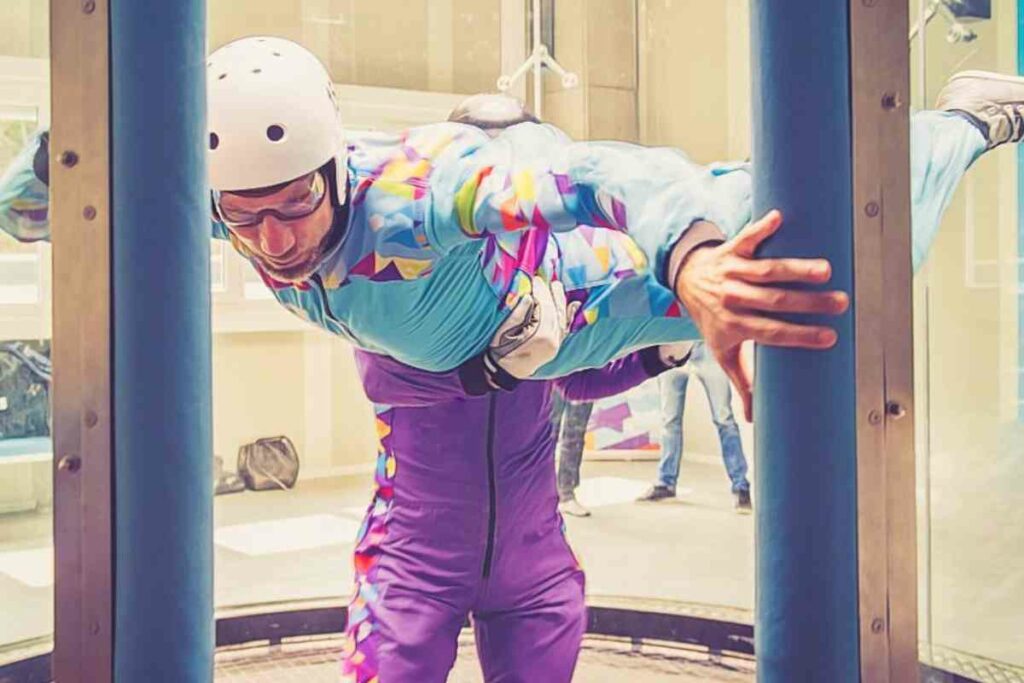Indoor skydiving is exactly what it says on the tin. Rather than jumping out of an airplane equipped with a parachute, you’re indoors.
In this article, we’ll cover one of the most common questions people ask about indoor skydiving, how high do you go? Read on.
Indoor Skydiving: The Basics
Indoor skydiving has quickly become a popular activity in the US. And with the number of indoor skydiving facilities nationwide, there are many opportunities to try this thrilling indoor adventure.
Before you go indoor skydiving, you must familiarize yourself with the concept to maximize your experience.
Read before you go – Can You Indoor Skydive If You Have a Medical Condition?
Here are some basic facts about indoor skydiving to bring you up to speed:
- Indoor skydiving happens in a wind tunnel, a vertical wind column that pumps air at high speeds.
- The vertical wind tunnel is powered by powerful fans that pump air from the surrounding environment upwards through the tunnel.
- The smooth and steady airflow allows the person in the flight chamber to float, replicating the feeling of falling through the sky.
- The speed of the fast-moving air is adjusted to match the flyer’s weight and allow them to experience freefall.
- Indoor skydiving is a fun adventure for all ages. Anyone that can wear a helmet will be allowed to fly.
- In most cases, indoor skydiving has weight restrictions, with most locations putting the weight limit at 250 pounds.
- You shouldn’t fly if you are pregnant or have neck, shoulder, or back injuries. People with heart problems shouldn’t go indoor skydiving, either.
Indoor skydiving is known for its inclusivity. You will be allowed to fly unless you have a health issue that disqualifies you from flying — such as heart problems or a previous injury that may be re-injured during the flight.
What to Expect? – Can You Indoor Skydive If You Have a Fear of Heights?
If you doubt whether you’ll be allowed to fly, contact the facility before your visit for confirmation.
How High Do You Fly In A Wind Tunnel Flight?
Since it’s done indoors, this form of skydiving is not dependent on the weather or season.
Unlike outdoor skydiving, rain, wind, the sun, etc., can’t stop you from defying gravity and reaching new heights. Speaking of heights, how high do you go during indoor skydiving?
How high you go in a wind tunnel flight will depend on your indoor skydiving experience and skill level. If you are starting, you can’t go very high.
You probably don’t know how to gain altitude in a wind tunnel, and wind speed won’t be high enough to propel you.
Another reason you can’t go as high as a newbie is that your instructor will be controlling your movements.
Inexperienced flyers can lose control, slam into walls, and get hurt. Your instructor is there to prevent that from happening.
Once you learn to control your movements and fly without assistance, you can fly as high as you want.
You can even go up to the ceiling, around 30 feet and the highest you can climb during indoor skydiving. However, you must know how to come down from that altitude.
Are you a rookie? For a wealth of information and helpful tips, take a look at this comprehensive beginner’s guide to indoor skydiving.
How High Can You Fly With An Instructor?
Many indoor skydiving facilities offer what’s referred to as high flights as part of the first wind tunnel experience.
Some centers will even provide the so-called high flight at an extra charge. It’s often included the grand finale of the flight session.
So, how high can you fly with an instructor as a newbie? The instructor will take the new flyer up to 20 feet in the air during a high flight. Typically, the instructor will have you at arm’s length throughout the flight.
It’s not as high as you get to go when you gain enough experience to fly unassisted, but it’s still pretty high.
Remember, this is only possible in indoor diving facilities offering high flights as part of the first-time experience or at a cost.
Conclusion
Now available in many large cities across the US, indoor skydiving is becoming popular as a recreational activity.
Knowing what to expect before your first indoor skydiving session will make the experience even more thrilling and comfortable if you’d like to try it out.







